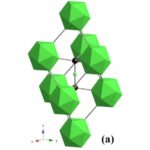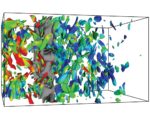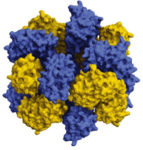Supercomputer simulations run on the Stampede2 system of the Texas Advanced Computing Center (TACC) have helped scientists studying how cells work understand the way in which protein molecules in a sense dance with a partner to respond to signals and regulate each other’s activities. Crucial to giving cells energy for life is the migration of […]
HPC vs. HIV-1: Stampede2, Bridges and Darwin Uncover Nucleotide Infection Process
By Jorge Salazar, Science Writer, Texas Advanced Computing Center Viruses lurk in the grey area between the living and the nonliving, according to scientists. Like living things, they replicate but they don’t do it on their own. The HIV-1 virus, like all viruses, needs to hijack a host cell through infection in order to make copies […]
Supercomputing the Mysteries of Boron Carbide
Researchers at the University of Florida are using XSEDE supercomputers to unlock the mysteries of boron carbide, one of the hardest materials on earth. The material is also very lightweight, which explains why it has been used in making vehicle armor and body protection for soldiers. The research, which primarily used the Comet supercomputer at the San Diego Supercomputer Center along with the Stampede and Stampede2 systems at the Texas Advanced Computing Center, may provide insight into better protective mechanisms for vehicle and soldier armor after further testing and development.
Simulating Shock Turbulence Interactions on Stampede II
In this special guest feature, Jorge Salazar from TACC writes that Researchers are using XSEDE supercomputers to better understand shock turbulence interactions. “We proposed that, instead of treating the shock as a discontinuity, one needs to account for its finite thickness as in real life which may be involved as a governing parameter in, for example, amplification factors,” Donzis said.
Podcast: Supercomputing Synthetic Biomolecules
Researchers are using HPC to design potentially life-saving proteins. In this TACC podcast, host Jorge Salazar discusses this groundbreaking work with the science team. “The scientists say their methods could be applied to useful technologies such as pharmaceutical targeting, artificial energy harvesting, ‘smart’ sensing and building materials, and more.”
Radio Free HPC Looks at Posit Computing
In this podcast, the Radio Free HPC team looks at the problems with IEEE Floating Point. “As described in a recent presentation by John Gustafson, the flaws and idiosyncrasies of floating-point arithmetic ‘constitute a sizable portion of any curriculum on Numerical Analysis.’ The whole thing has Dan pretty worked up, so we hope that the news of Posit Computing coming to the new processors from Rex Computing will help.”
18 Petaflop Stampede2 Supercomputer Dedicated at TACC
Stampede2 is the newest strategic supercomputing resource for the nation’s research and education community, enabling scientists and engineers across the U.S., from multiple disciplines, to answer questions at the forefront of science and engineering. “Building on the success of the initial Stampede system, the Stampede team has partnered with other institutions as well as industry to bring the latest in forward-looking computing technologies combined with deep computational and data science expertise to take on some of the most challenging science and engineering frontiers,” said Irene Qualters, director of NSF’s Office of Advanced Cyberinfrastructure.
Stampede 2 Supercomputer at TACC to Sport 18 Petaflops
Over at the Dell HPC Community, Jim Ganthier writes that TACC is planning to deploy its 18 Petflop Stampede 2 supercomputer based on Dell servers running Intel Knights Landing processors. “Stampede 2 will do more than just meet growing demand from those who run data-intensive research. Imagine the discoveries that will be made as a result of this award and the new system. Now more than ever is an exciting time to be in HPC.”









